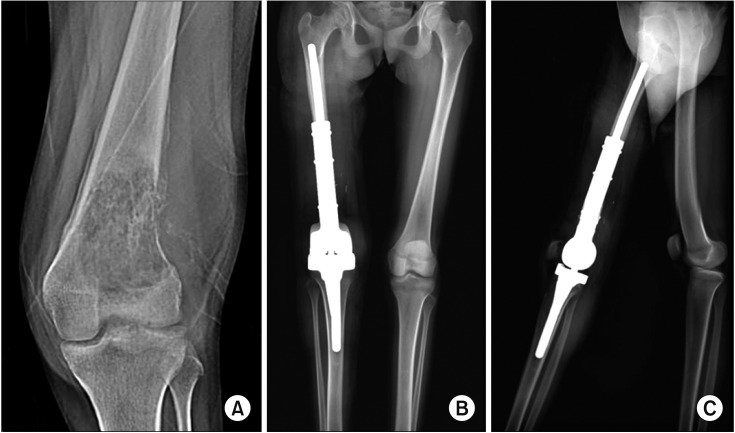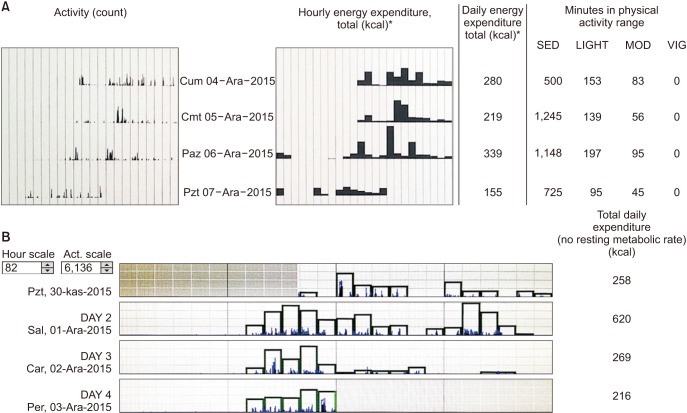Clin Orthop Surg.
2018 Dec;10(4):491-499. 10.4055/cios.2018.10.4.491.
Analysis of Postural Stability and Daily Energy Expenditure to Manage Tumor Patients' Functional Expectation
- Affiliations
-
- 1Department of Orthopaedics, Ankara Numune Training and Research Hospital, Ankara, Turkey. dremrahcaliskan@gmail.com
- 2Department of Physical Therapy and Rehabilitation, Marmara University, Istanbul, Turkey.
- 3Department of Sports Physiology, Marmara University, Istanbul, Turkey.
- 4Department of Orthopaedics, Marmara University, Istanbul, Turkey.
- KMID: 2426536
- DOI: http://doi.org/10.4055/cios.2018.10.4.491
Abstract
- BACKGROUND
Advances in surgical techniques, implant technology, radiotherapy, and chemotherapy have increased the recovery chances of patients with bone sarcomas. Accordingly, patients' expectations on life quality have also increased, highlighting the importance of objective evaluation of the functional results of reconstruction.
METHODS
Thirteen patients with distal femoral endoprosthesis, who had been followed for an average of 2.9 years were evaluated. Postural stability, daily energy expenditure, muscle power, and range of motion were the four parameters analyzed in this study. The Musculoskeletal Tumor Society (MSTS) score and Toronto Extremity Salvage Score (TESS) were used to assess postoperative function and examine correlations with other parameters.
RESULTS
Patients had sedentary activities in 84% of their daily lives. They exhibited a slower speed in the walk across test and a higher sway velocity in the sit-to-stand test (p = 0.005). MSTS scores were significantly correlated with the daily energy expenditure and walking speed.
CONCLUSIONS
Objective functional results acquired from various clinics will provide significant data to compare reconstruction techniques, rehabilitation protocols, and surgical techniques. In this way, it will be possible to satisfy the expectations of patients that increase in relation to enhanced recovery.
Keyword
MeSH Terms
Figure
Reference
-
1. Myers GJ, Abudu AT, Carter SR, Tillman RM, Grimer RJ. The long-term results of endoprosthetic replacement of the proximal tibia for bone tumours. J Bone Joint Surg Br. 2007; 89(12):1632–1637. PMID: 18057365.
Article2. Griffin AM, Parsons JA, Davis AM, Bell RS, Wunder JS. Uncemented tumor endoprostheses at the knee: root causes of failure. Clin Orthop Relat Res. 2005; 438:71–79. PMID: 16131872.3. Hassan BS, Mockett S, Doherty M. Static postural sway, proprioception, and maximal voluntary quadriceps contraction in patients with knee osteoarthritis and normal control subjects. Ann Rheum Dis. 2001; 60(6):612–618. PMID: 11350851.
Article4. Montoye AH, Pfeiffer KA, Suton D, Trost SG. Evaluating the responsiveness of accelerometry to detect change in physical activity. Meas Phys Educ Exerc Sci. 2014; 18(4):273–285. PMID: 25284973.
Article5. Bernthal NM, Greenberg M, Heberer K, Eckardt JJ, Fowler EG. What are the functional outcomes of endoprosthestic reconstructions after tumor resection. Clin Orthop Relat Res. 2015; 473(3):812–819. PMID: 24777730.
Article6. American Academy of Orthopaedic Surgeons. Joint motion: method of measuring and recording. Edinburgh: Churchill Livingstone;1974. p. 87–89.7. Hallaceli H, Uruc V, Uysal HH, et al. Normal hip, knee and ankle range of motion in the Turkish population. Acta Orthop Traumatol Turc. 2014; 48(1):37–42. PMID: 24643098.
Article8. Thorborg K, Petersen J, Magnusson SP, Holmich P. Clinical assessment of hip strength using a hand-held dynamometer is reliable. Scand J Med Sci Sports. 2010; 20(3):493–501. PMID: 19558384.
Article9. Roy MA, Doherty TJ. Reliability of hand-held dynamometry in assessment of knee extensor strength after hip fracture. Am J Phys Med Rehabil. 2004; 83(11):813–818. PMID: 15502733.
Article10. Evenson KR, Catellier DJ, Gill K, Ondrak KS, McMurray RG. Calibration of two objective measures of physical activity for children. J Sports Sci. 2008; 26(14):1557–1565. PMID: 18949660.
Article11. Brandes M, Schomaker R, Mollenhoff G, Rosenbaum D. Quantity versus quality of gait and quality of life in patients with osteoarthritis. Gait Posture. 2008; 28(1):74–79. PMID: 18054233.
Article12. Tas S, Guneri S, Kaymak B, Erden Z. A comparison of results of 3-dimensional gait analysis and observational gait analysis in patients with knee osteoarthritis. Acta Orthop Traumatol Turc. 2015; 49(2):151–159. PMID: 26012936.13. Sahin G. The assessment methods of physical activity level in elderly. Turk J Geriatr. 2010; 14(2):172–178.14. Swanik CB, Lephart SM, Rubash HE. Proprioception, kinesthesia, and balance after total knee arthroplasty with cruciate-retaining and posterior stabilized prostheses. J Bone Joint Surg Am. 2004; 86(2):328–334. PMID: 14960678.
Article15. Hue OA, Seynnes O, Ledrole D, Colson SS, Bernard PL. Effects of a physical activity program on postural stability in older people. Aging Clin Exp Res. 2004; 16(5):356–362. PMID: 15636460.
Article16. Schwartz I, Kandel L, Sajina A, Litinezki D, Herman A, Mattan Y. Balance is an important predictive factor for quality of life and function after primary total knee replacement. J Bone Joint Surg Br. 2012; 94(6):782–786. PMID: 22628592.
Article17. Rosenbaum D, Brandes M, Hardes J, Gosheger G, Rodl R. Physical activity levels after limb salvage surgery are not related to clinical scores-objective activity assessment in 22 patients after malignant bone tumor treatment with modular prostheses. J Surg Oncol. 2008; 98(2):97–100. PMID: 18521841.
Article18. Harding P, Holland AE, Delany C, Hinman RS. Do activity levels increase after total hip and knee arthroplasty? Clin Orthop Relat Res. 2014; 472(5):1502–1511. PMID: 24353051.
Article19. Paxton RJ, Melanson EL, Stevens-Lapsley JE, Christiansen CL. Physical activity after total knee arthroplasty: a critical review. World J Orthop. 2015; 6(8):614–622. PMID: 26396937.
Article20. Vahtrik D, Ereline J, Gapeyeva H, Paasuke M. Postural stability in relation to anthropometric and functional characteristics in women with knee osteoarthritis following total knee arthroplasty. Arch Orthop Trauma Surg. 2014; 134(5):685–692. PMID: 24525797.
Article21. Okita Y, Tatematsu N, Nagai K, et al. Compensation by nonoperated joints in the lower limbs during walking after endoprosthetic knee replacement following bone tumor resection. Clin Biomech (Bristol, Avon). 2013; 28(8):898–903.
Article
- Full Text Links
- Actions
-
Cited
- CITED
-
- Close
- Share
- Similar articles
-
- The Study of Daily Physical Activity in Old Women using Pedometer with Accelerometer
- Assessment of Daily steps, Activity coefficient, Body composition, Resting Energy Expenditure and Daily Energy Expenditure in Female University Students
- Measurement Methods for Physical Activity and Energy Expenditure: a Review
- Comparisons of the Daily Activities and Energy Expenditures of Normally-Weighted and Obese Elementary School Children
- The Test of Validity Using an Accelerometer for the Assessment of Physical Activity-related Eenergy Expenditure




